
The literal translation of Stadtpark is “city park”. But it offers much more than the name suggests. In fact, consider it a rather nice place for walking hand-in-hand with a significant other while you debate which museum to visit next.
- A green oasis in Vienna’s centre
- Contains composer statues and memorials
- Notably the Golden Strauss figure
- Home to the neo-Renaissance Kursalon
- Good place to take a break from sightseeing
- Book a Mozart & Strauss concert* at the Kursalon
- See also:
History and location
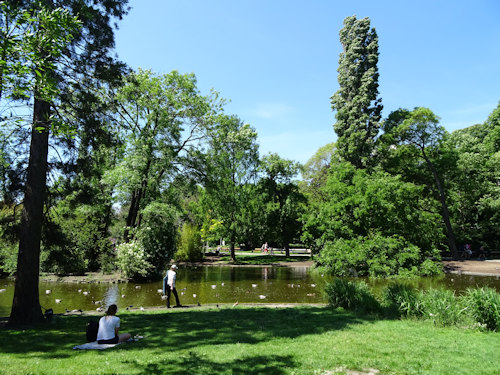
(An unexpectedly green view in the very centre of Vienna)
Consider the Stadtpark a little haven of tranquility, where you can take a pause from the sightseeing, watch the ducks float lazily by, and gasp at the koi carp, which are the kind of size heron’s dream about.
(You can find herons here, too.)
All is kept in shape by the Viennese parks authority (Wiener Stadtgärten), who do a marvellous job of maintaining the city’s green spaces.
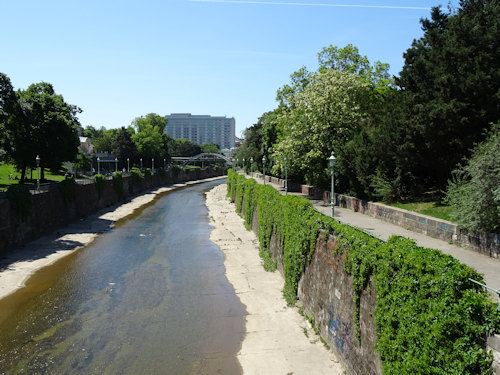
(The River Wien and NOT the Danube)
The Stadtpark first opened in 1862, its flow and layout very much reflecting an English approach to landscape design. It runs some 500m along the section of the central Ring boulevard called Parkring (creative naming really wasn’t a strength back then).
The northern end faces the MAK (the Museum of Applied Arts) and the southern end is home to the Kursalon, an impressive Renaissance-style 19th-century building that’s now a venue, particularly for classical concerts.
Trees, water & music
Winding paths, a mix of trees and shrubs, statues, and water features fill the bits between the two ends.
The River Wien also flows almost apologetically through the Stadtpark, fully aware that some people mistake it for the Danube and go home very disappointed.
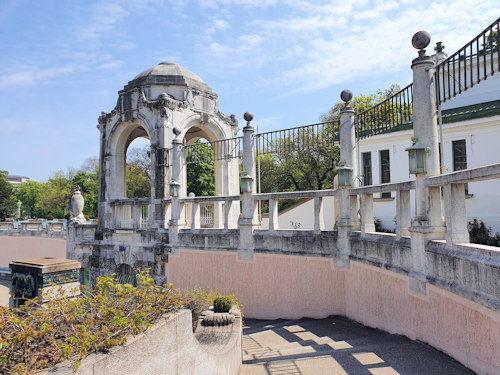
(A Jugendstil park entrance)
The course of the Wien is mostly man-made now (it even disappears underground for much of its time in the city): the banks evoke memories of classical Rome and actually make a pleasant enough walk.
Fans of Jugendstil will also enjoy the architecture along the banks, particularly around the portal and stairs that connect Johannesgasse with the paths bounding the river.
That portal even featured prominently in Season 2 of Vienna Blood, as did the Stadtpark itself and the Kursalon.
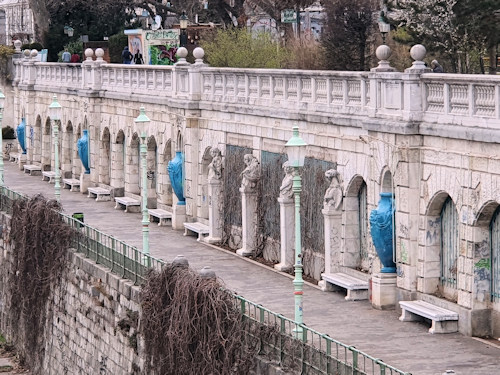
(The walkway along the River Wien)
The trees in the park form a delightful blend of colours and shapes, and the grassy areas invite you to linger a while, enjoy the sun (if there is any) and sigh contentedly at the prospect of your next Wiener Schnitzel.
Following the paths also takes you past memorials to some of the great Austro-Hungarian composers, including Franz Lehár (composer of the Merry Widow operetta) and Anton Bruckner (who inspired, for example, Mahler).
Franz Schubert (no introduction required) gets his own statue, too.
Chief among these monuments, though, is the memorial to Johann Strauss II, the King of the Waltz, whose tunes are as Viennese as coffee and Sachertorte.
The golden statue of Strauss on his violin has become an iconic photo opportunity, so attracts a lot of visitors. At peak times, a queue of people wait for a photo with Johann, much like an official fan “meet and greet” with a Hollywood star.
Talking of coffee and Sachertorte, the park features one or two places to eat and drink.
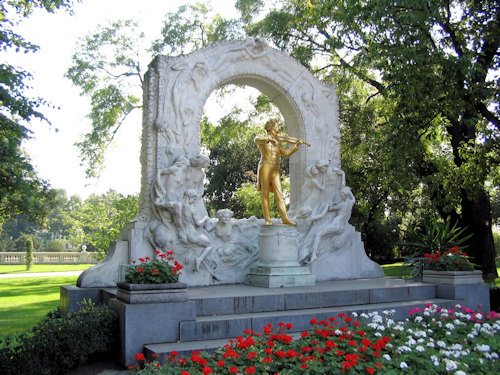
(One of Vienna’s most popular photo motifs)
We popped in for a small beer and elderflower cordial at the Meierei im Stadtpark, which sits next to the River Wien and is a member of the high-quality Steirereck family of restaurants. It dates back to 1903 when people went there to drink milk.
How to get to the Stadtpark
Given its size and location, you can find and reach the Stadtpark easily.
Subway: the park has its own station (Stadtpark on the U4 line) and is also close to Stubentor (U3) and Wien Mitte-Landstraße (U3 and U4).
(The Stadtpark station building is actually an iconic Otto Wagner white and apple green design.)
Tram: Line 2 to Weihburggasse (the stop is on Parkring) or Stubentor
Bus: 3A or 74A to Stubentor
Address: Stadtpark, Parkring, 1010 Vienna